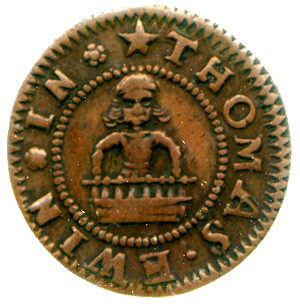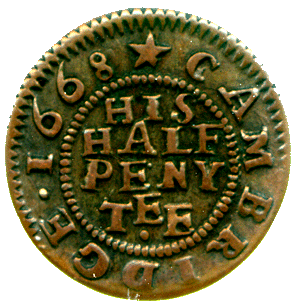.jpg)
Obverse of a 19th-century silver shilling token of Bristol, Queens' College Collection, CM.QC.4014-R
.jpg)
Obverse of a 19th-century silver shilling token of Bristol, Queens' College Collection, CM.QC.4014-R
At various points in British history the supply of official money issued by the state has become sufficiently scant that unofficial coinage has entered circulation. This has applied especially to small-value coins, in whose manufacture there is little profit for the state and which the government does not need for its own expenditure. For the common working man, however, the absence of lesser denominations made simple transactions very difficult. For example, if he was paid fifteen silver shillings a week, but wished to buy bread worth three halfpence, his coins were each worth much more, and the shopkeeper would not easily be able to refund the difference as change. Particular periods of such change shortage were the years around the English Civil War and the French Revolutionary and Napoleonic Wars, and both generated a substantial 'token' coinage of lesser denominations to supply the want, which are now highly collectable and of great historical interest.


A copper farthing token of Thomas Ewin, Cambridge, 1668, CM.BI.247-R
Find out more about this token...
The main difference between the tokens of the eighteenth century and those of earlier periods was that for the first time, due to the developing copper industry making the metal available in greater quantities and more cheaply than ever before, and due to new techniques employed, for instance, by the famous Soho mint of Matthew Boulton, it was possible for such pieces to be cheaply made in large numbers by machine. At the same time, there was a number of extremely talented engravers who could be hired, through the mints, by those who wished to issue such tokens and their artistry accurately reproduced token for token until their dies wore out. (Many of the more numerous issues went through dozens of dies, providing regular work for the engravers.) The period therefore saw the wide circulation of numerous pieces which qualified as genuine works of art, and the number of collectors of these tokens proved to be so great that, although large-scale currency issues mostly ceased after 1792, large numbers of low mintage issues continued to be made solely for such enthusiasts, with no intent of being used as commercial coin.
.jpg)
.jpg)
A copper halfpenny token issued by Dodd of London, 1785, Queens' College Collection, CM.QC.3721-R
Since such tokens needed to be redeemable, at least in theory, in order to be accepted, they bore the names of their issuers. Some, like Mr Dodd above, were unable to resist the temptation to display themselves in regal style after the manner of coin of the realm. Others, seeing the opportunities implicit in a medium that passed from hand to hand so readily, advertised their goods and premises in more elaborate ways:
.jpg)
Obverse of a copper halfpenny token of Basil Burchell, a London druggist, late eighteenth century, Queens' College Collection, CM.QC.3707-R (double size image)
.jpg)
Reverse of a copper halfpenny token of Kelly's Saddlery, London, late eighteenth century, CM.49-1997 (double size image)
.jpg)
Obverse of a copper halfpenny token issued by Niblock of Bristol, 1795; the speech-bubbles read, "I want to buy some cheap bargains·" and "Then go to Niblock's, Bridge Street·". Spencer George Perceval Bequest, CM.4.446-1922 (double size image).
Ready adopters of the vivid depictions that could be passed into people's pockets by token advertising were the owners of theatres and circuses. The largest series of issues was perhaps that issued by Gilbert Pidcock, proprietor of Pidcock's Menagerie on the Strand (a difficult thing to imagine now!).
.jpg) (Obverse of a copper halfpenny token engraved by C. James on behalf of William Lutwyche for Gilbert Pidcock, 1795, advertising Pidcock's Menagerie; Spencer George Perceval Collection, CM.4.404-1922) |
 (Line drawing of the Menagerie on the Strand in later years under the ownership of Edward Cross) |
Pidcock's were not the only tokens advertising such entertainment.
.jpg) (Left, obverse of a copper halfpenny token engraved by Roger Dixon and struck by Lutwyche for the Lyceum Theatre, Strand, late eighteenth century, Queens' College Collection, CM.QC.3741-R.)
(Left, obverse of a copper halfpenny token engraved by Roger Dixon and struck by Lutwyche for the Lyceum Theatre, Strand, late eighteenth century, Queens' College Collection, CM.QC.3741-R.)
.jpg) (Right, reverse of a copper halfpenny token engraved by Benjamin Jacobs and struck by Peter Skidmore for an unknown issuer, late eighteenth century, Queens' College Collection, CM.QC.3732-R.)
(Right, reverse of a copper halfpenny token engraved by Benjamin Jacobs and struck by Peter Skidmore for an unknown issuer, late eighteenth century, Queens' College Collection, CM.QC.3732-R.)
Particularly in London, where the market was largest because of the density of population, tokens were sold as goods themselves, pieces of artistic or even historical interest for the number of collectors that had grown up around these unofficial monies. Sometimes this intent was explicitly declared.
.jpg)
(Reverse of a copper halfpenny issued for Flitwick by Skidmore, 1797, inscribed: "DEDICATED TO COLLECTORS OF MEDALS AND COINS" (double size image), Peterhouse Collection, CM.P.306-1960.)
Such issues were particularly struck by Peter Kempson of Kempson & Kindon in Birmingham and John Skidmore in London. Both Kempson and Skidmore issued many tokens depicting various famous buildings of the age, especially in London, some of which are immediately recognisable even today to those who have seen them...
.jpg) (Obverse of a copper halfpenny by Thomas Wyon for Peter Kempson showing Mansion House, late eighteenth century, Spencer George Perceval Collection, CM.4.417-1922.)
(Obverse of a copper halfpenny by Thomas Wyon for Peter Kempson showing Mansion House, late eighteenth century, Spencer George Perceval Collection, CM.4.417-1922.)
... some of which have now gone...
.jpg) (Obverse of a copper halfpenny token engraved by Benjamin Jacobs for Skidmore's Buildings series, late eighteenth century, showing Aldgate as it was in 1796; CM.797-1910.)
(Obverse of a copper halfpenny token engraved by Benjamin Jacobs for Skidmore's Buildings series, late eighteenth century, showing Aldgate as it was in 1796; CM.797-1910.)
... and some of which were already past when depicted!
.jpg)
(Reverse of a copper halfpenny token engraved by C. James for Skidmore, late eighteenth century, showing the church of St Paul's Covent Garden after its destruction by fire in 1795, CM.BI.1892-R.)
Commercial or artistic messages, however, were not the only ones that could be passed by such means...
Continue...